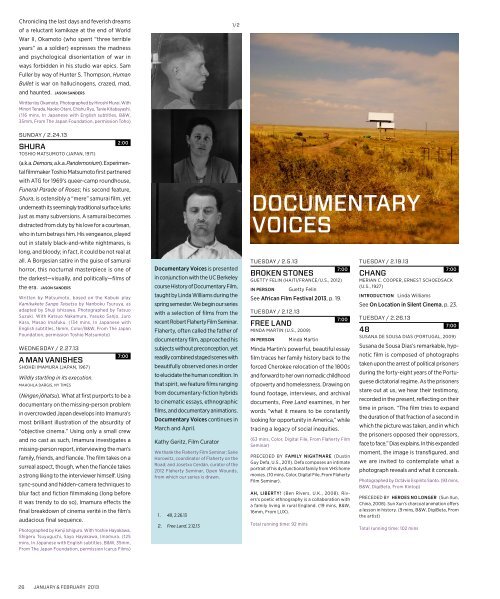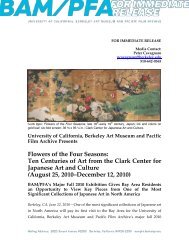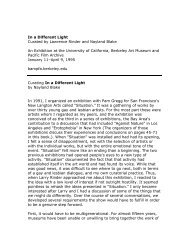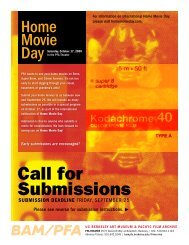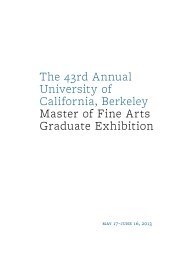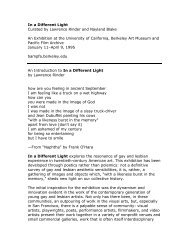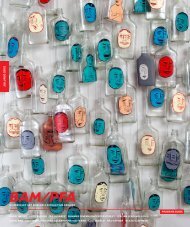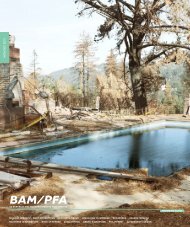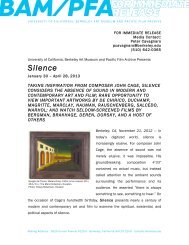January & February 2013 - Berkeley Art Museum and Pacific Film ...
January & February 2013 - Berkeley Art Museum and Pacific Film ...
January & February 2013 - Berkeley Art Museum and Pacific Film ...
- No tags were found...
You also want an ePaper? Increase the reach of your titles
YUMPU automatically turns print PDFs into web optimized ePapers that Google loves.
Chronicling the last days <strong>and</strong> feverish dreamsof a reluctant kamikaze at the end of WorldWar II, Okamoto (who spent “three terribleyears” as a soldier) expresses the madness<strong>and</strong> psychological disorientation of war inways forbidden in his studio war epics. SamFuller by way of Hunter S. Thompson, HumanBullet is war on hallucinogens, crazed, mad,<strong>and</strong> haunted. Jason S<strong>and</strong>ers1/2Written by Okamoto. Photographed by Hiroshi Murai. WithMinori Terada, Naoko Otani, Chishu Ryu, Tanie Kitabayashi.(116 mins, In Japanese with English subtitles, B&W,35mm, From The Japan Foundation, permission Toho)Sunday / 2.24.132:00ShuraToshio Matsumoto (Japan, 1971)(a.k.a. Demons, a.k.a. P<strong>and</strong>emonium). Experimentalfilmmaker Toshio Matsumoto first partneredwith ATG for 1969’s queer-camp roundhouse,Funeral Parade of Roses; his second feature,Shura, is ostensibly a “mere” samurai film, yetunderneath its seemingly traditional surface lurksjust as many subversions. A samurai becomesdistracted from duty by his love for a courtesan,who in turn betrays him. His vengeance, playedout in stately black-<strong>and</strong>-white nightmares, islong, <strong>and</strong> bloody; in fact, it could be not real atall. A Borgesian satire in the guise of samuraihorror, this nocturnal masterpiece is one ofthe darkest—visually, <strong>and</strong> politically—films ofthe era. Jason S<strong>and</strong>ersWritten by Matsumoto, based on the Kabuki playKamikakete Sango Taisetsu by Nanboku Tsuruya, asadapted by Shuji Ishizawa. Photographed by TatsuoSuzuki. With Katsuo Nakamura, Yasuko Sanjo, JuroKara, Masao Imafuku. (134 mins, In Japanese withEnglish subtitles, 16mm, Color/B&W, From The JapanFoundation, permission Toshio Matsumoto)Wednesday / 2.27.13A Man VanishesShohei Imamura (Japan, 1967)Wildly startling in its execution.Mahohla Dargis, NY Times7:00(Ningen jōhatsu). What at first purports to be adocumentary on the missing-person problemin overcrowded Japan develops into Imamura’smost brilliant illustration of the absurdity of“objective cinema.” Using only a small crew<strong>and</strong> no cast as such, Imamura investigates amissing-person report, interviewing the man’sfamily, friends, <strong>and</strong> fiancée. The film takes on asurreal aspect, though, when the fiancée takesa strong liking to the interviewer himself. Usingsync-sound <strong>and</strong> hidden-camera techniques toblur fact <strong>and</strong> fiction filmmaking (long beforeit was trendy to do so), Imamura effects thefinal breakdown of cinema verité in the film’saudacious final sequence.Photographed by Kenji Ishiguro. With Yoshie Hayakawa,Shigeru Tsuyuguchi, Sayo Hayakawa, Imamura. (125mins, In Japanese with English subtitles, B&W, 35mm,From The Japan Foundation, permission Icarus <strong>Film</strong>s)Documentary Voices is presentedin conjunction with the UC <strong>Berkeley</strong>course History of Documentary <strong>Film</strong>,taught by Linda Williams during thespring semester. We begin our serieswith a selection of films from therecent Robert Flaherty <strong>Film</strong> Seminar.Flaherty, often called the father ofdocumentary film, approached hissubjects without preconception, yetreadily combined staged scenes withbeautifully observed ones in orderto elucidate the human condition. Inthat spirit, we feature films rangingfrom documentary-fiction hybridsto cinematic essays, ethnographicfilms, <strong>and</strong> documentary animations.Documentary Voices continues inMarch <strong>and</strong> April.Kathy Geritz, <strong>Film</strong> CuratorWe thank the Flaherty <strong>Film</strong> Seminar; SarieHorowitz, coordinator of Flaherty on theRoad; <strong>and</strong> Josetxo Cerdán, curator of the2012 Flaherty Seminar, Open Wounds,from which our series is drawn.1. 48, 2.26.132. Free L<strong>and</strong>, 2.12.13documentaryvoicesTuesday / 2.5.137:00Broken StonesGuetty Felin (Haiti/France/U.S., 2012)In PersonGuetty FelinSee African <strong>Film</strong> Festival <strong>2013</strong>, p. 19.Tuesday / 2.12.13Free L<strong>and</strong>Minda Martin (U.S., 2009)In PersonMinda Martin7:00Minda Martin’s powerful, beautiful essayfilm traces her family history back to theforced Cherokee relocation of the 1800s<strong>and</strong> forward to her own nomadic childhoodof poverty <strong>and</strong> homelessness. Drawing onfound footage, interviews, <strong>and</strong> archivaldocuments, Free L<strong>and</strong> examines, in herwords “what it means to be constantlylooking for opportunity in America,” whiletracing a legacy of social inequities.(63 mins, Color, Digital File, From Flaherty <strong>Film</strong>Seminar)Preceded by Family Nightmare (DustinGuy Defa, U.S., 2011). Defa composes an intimateportrait of his dysfunctional family from VHS homemovies. (10 mins, Color, Digital File, From Flaherty<strong>Film</strong> Seminar).Ah, Liberty! (Ben Rivers, U.K., 2008). Rivers’spoetic ethnography is a collaboration witha family living in rural Engl<strong>and</strong>. (19 mins, B&W,16mm, From LUX).Total running time: 92 minsTuesday / 2.19.137:00ChangMerian C. Cooper, Ernest Schoedsack(U.S., 1927)Introduction Linda WilliamsSee On Location in Silent Cinema, p. 23.Tuesday / 2.26.137:0048Susana de Sousa Dias (Portugal, 2009)Susana de Sousa Dias’s remarkable, hypnoticfilm is composed of photographstaken upon the arrest of political prisonersduring the forty-eight years of the Portuguesedictatorial regime. As the prisonersstare out at us, we hear their testimony,recorded in the present, reflecting on theirtime in prison. “The film tries to exp<strong>and</strong>the duration of that fraction of a second inwhich the picture was taken, <strong>and</strong> in whichthe prisoners opposed their oppressors,face to face,” Dias explains. In this exp<strong>and</strong>edmoment, the image is transfigured, <strong>and</strong>we are invited to contemplate what aphotograph reveals <strong>and</strong> what it conceals.Photographed by Octávio Espírito Santo. (93 mins,B&W, DigiBeta, From Kintop)Preceded by Heroes No Longer (Sun Xun,China, 2008). Sun Xun’s charcoal animation offersa lesson in history. (9 mins, B&W, DigiBeta, Fromthe artist)Total running time: 102 mins26 january & FEBRuary <strong>2013</strong>


